PSEB Class 10 Biology Solutions For Chapter 3: Heredity And Evolution
Heredity
Heredity means transmission of characters (traits) from parents to offsprings. These can be physical traits (e.g. eye colour, blood type or a disease), or behavioural traits.
Genetics- Branch of science that deals with heredity and variation.
Read And Learn More PSEB Class 10 Biology
Three Reasons For Variations During Reproduction
- Errors in DNA copying.
- Random fertilization.
- Crossing over during meiosis.
Reason For Variations In Asexual Reproduction
- Variations occur only due to defects in DNA copying.
- Since only one parent is involved, the genetic materials are transferred from only one parent. As a result, the frequency of variation among offspring is very less.
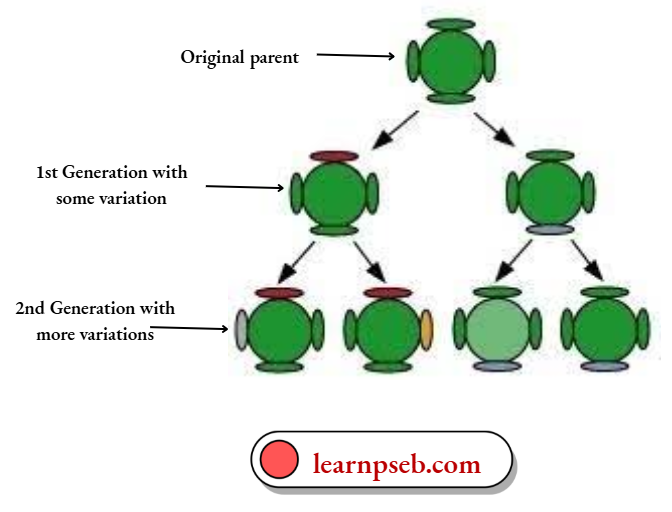
Reasons For Variations In Sexual Reproduction
- Variations can occur due to one or more of the following reasons – errors in DNA copying, random fertilization, crossing over during meiosis.
- Since gametes from two separate people are fused, variations take place at a higher frequency.
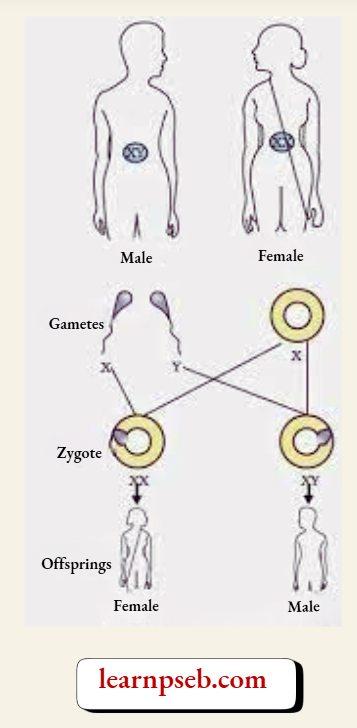
Mendel’s Contribution- Rules Of Inheritance Based On Experiments On Garden Peas
- Characters are transferred from the parents to the offsprings through genes. These genes are present in the DNA molecules in the chromosomes.
- Both the father and the mother contribute equal amounts of genetic material to the child. This means that each trait can be influenced by both paternal and maternal DNA. Thus, for each trait there will be two versions (one from the father and the other from the mother) in each child.
Simple Trick To Remember Seven Pairs Of Contrasting Characters Selected By Mendel
With the help of the mnemonic “SSCCPPF” one can easily remember the seven pairs of contrasting characters selected by Mendel for conducting experiments on pea plants
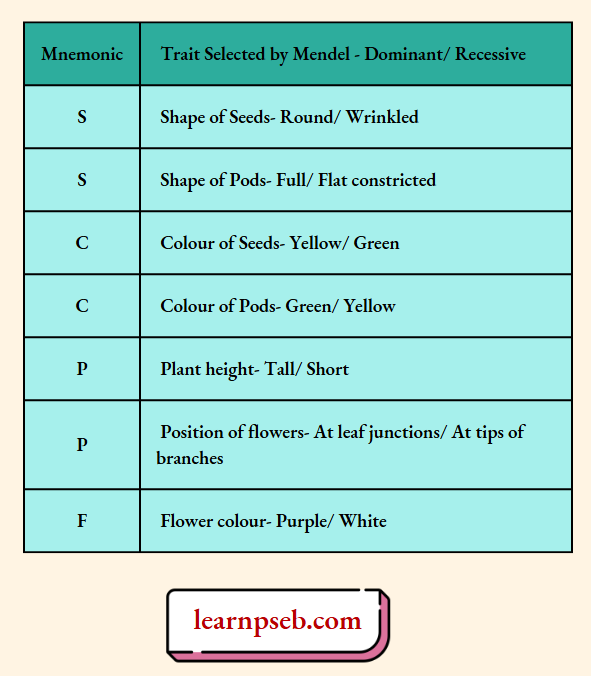
Mendel’s Experiments- Monohybrid Cross
- Cross pollination of plants having one pair of characters- a pure tall pea plant (TT) and a pure dwarf pea plant (tt).
- F1 generation- All tall plants were obtained.
- Self-pollination of plants of FI generation.
- F2 generation – Tall and dwarf plants obtained in the ratio 3:1 (Phenotypic ratio) and 1:2:1 :: TT: Tt: tt (Genotypic ratio).
- Trait expressed in FI generation is dominant trait, while the trait suppressed in FI generation is recessive trait.
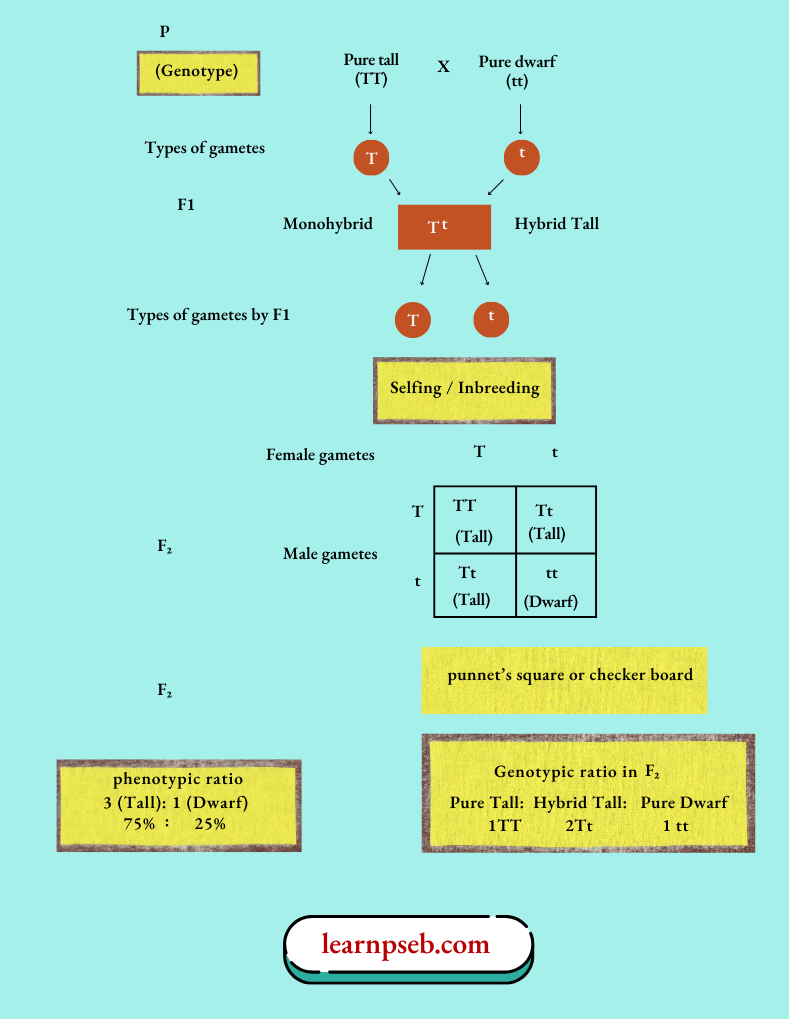
Mendel’s Experiments- Dihybrid Cross
- Cross pollination of plants having two pairs of characters, viz. colour and shape of seeds, i.e, Round Yellow seeds (RRYY) and Wrinkled Green seeds (rryy).
- F1 generation, all plants having round yellow seeds (RrYy) were obtained.
- Self-pollination of plants of F1 generation.
- F2 generation (16 plants were obtained) Phenotypic Ratio- 9:3:3:1 [9 had round yellow seeds (RrYy), 3 had round green seeds (Rryy), 3 had wrinkled yellow seeds (rrYy), and 1 had wrinkled green seeds (rryy)]. Genotypic Ratio (Nine genotypes were obtained)– 1:2:2:4:1:2:1:2:1
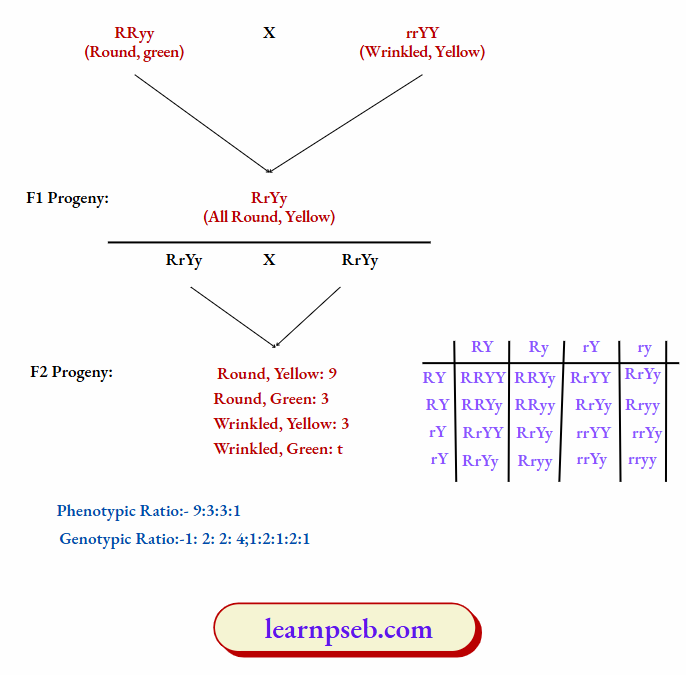
Simple Trick To Learn Genotypic Ratio In Dihybrid Cross
- Remember that there will be 9 genotypes in dihybrid cross.
- Now write the first gene combination 3 times each, i.e., RR, Rr and rr need to be written three times each.
- Write the other gene combination only once, i.e., YY, Yy and yy, and then repeat this three times.
- Write ratio as 1:2:1 from top, and 1:2:1 from bottom.
- In the middle three rows double the ratios written in the first three rows. This will give the genotypic ratio in dihybrid cross (1:2:1:2:4:2:1:2:1).
These steps are shown below:
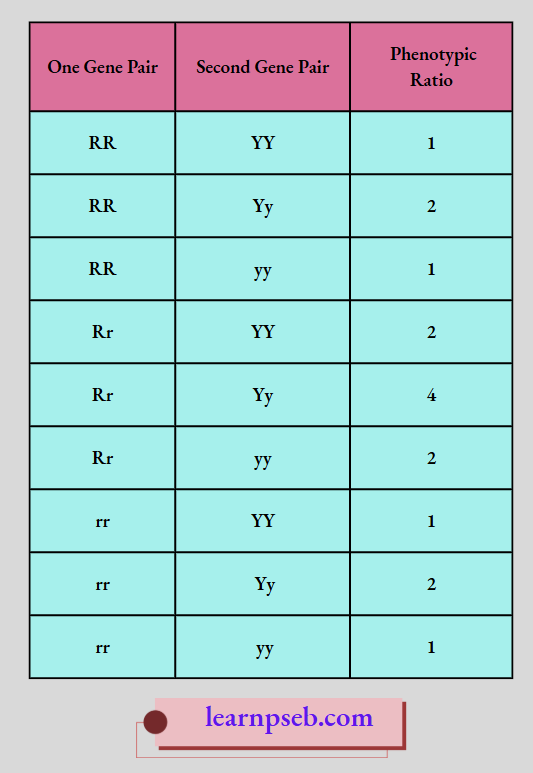
Mendel’s Laws Of Inheritance
- Law Of Dominance – If the set of alleles comes from parent (male and female) to offspring then, the dominant allele is expressed and the recessive allele has no noticeable effect.
- Law Of Segregation – The two alleles for a character separate during gamete formation (notice separation of alleles in FI and F2 generation of monohybrid and dihybrid cross).
- Law Of Independent Assortment or Inheritance – The two pair of alleles are inherited independently of each other.
Some Important Terms
- DNA- It is the information source for making proteins in the cell.
- Gene- A section of DNA that provides information for one protein is called the gene for that protein. Characteristics or traits of an organism are controlled by genes.
- Allele- An allele is one of two or more versions of a gene. e.g. TT, tt, Tt. An individual inherits two alleles for each gene, one from each parent.
- Homozygous- It means that the organism has two copies of the same allele for a gene. e.g. TT, tt.
- Heterozygous- It means that the organism has two different alleles of a gene. e.g. Tt.
- Phenotype- The trait which is visible in an organism is called its phenotype, e.g. Phenotypic ratio in F2 generation of monohybrid cross is 3:1.
- Genotype- The actual composition of genes present in an organism is called its genotype, e.g. Genotypic ratio in F2 generation of monohybrid cross is 1:2:1.
Sex Determination- The process of determining the biological sex of an offspring before its birth. Different strategies are used by different species for sex determination such as environmental factors and genetics.
Summary Of Sex Determination Methods In Different Species
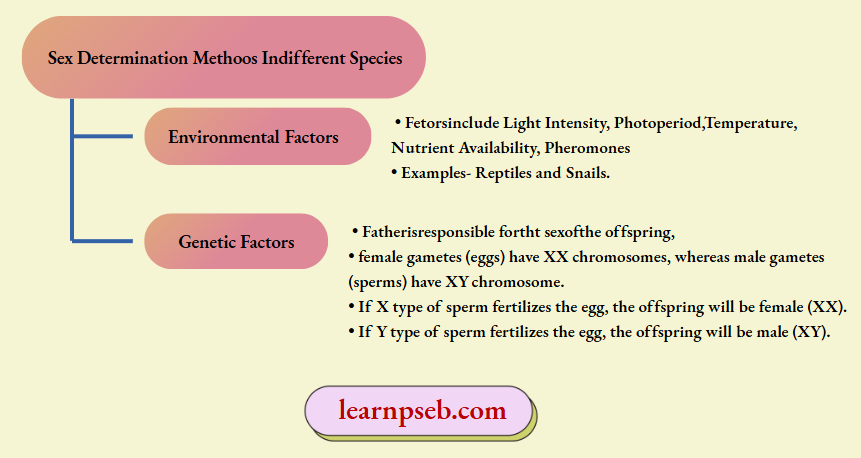
Sex Determination In Humans – Genetic Factors
- In human, sex of the offsprings is largely genetically determinied, and father is resp[onsible for the sex of the offspring.
- Humans have 23 pairs of chromosomes – 22 pairs of XX chromosomes (one X in each pair comes from mother and the other X comes from father) + 1 pair of sex chromosome (women have XX, while men have XY).
- During gamets formation, separation of chromosomes takes place. therefore, males produce two types of sperms X and Y, while female produces one type of egg X.
- If a X type of sperm fertilizes the egg then offspring will be female (XX). If Y type of sperm fertilizes the egg then offspring will be male (XY). Thus, the sex of the offspring will be determined by what they inherit from their father.
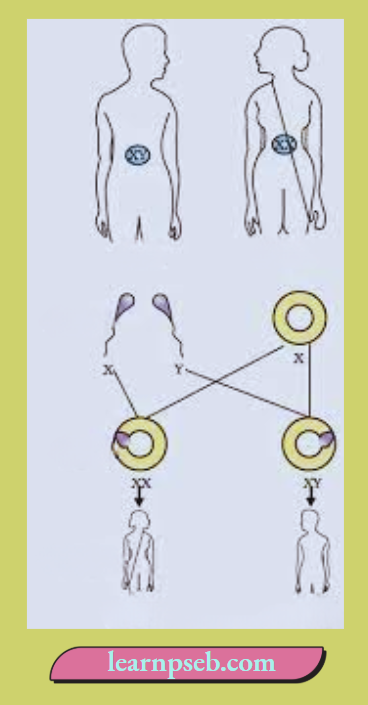
Chapter 3 Heredity And Evolution Reason-Assertion Questions And Answers
For question provided below, two statements are given—one labelled Assertion (A) and the other labelled Reason (R). Select the correct answer to these questions from the codes (a), (b), (c) and (d) as given below:
- Both A and R are true, and R is the correct explanation of the assertion.
- Both A and R are true, but R is not the correct explanation of the assertion.
- A is true, but R is false.
- A is false, but R is true.
Question 1. Assertion: Mendel chose pea plant for his experiments.
Reason: Pea plant provides diverse visible traits and has a short life span.
Answer: 1. Both A and R are true, and R is the correct explanation of the assertion.
Question 2. Assertion: When TT and tt pea plant were crossed, only tall plants were obtained in FI progeny.
Reason: This was because tall allele was dominant over the short allele.
Answer: 1. Both A and R are true, and R is the correct explanation of the assertion.
Question 3. Assertion: A geneticist crossed a pea plant having violet flowers with a pea plant with white flowers, he got all violet flowers in first generation.
Reason: White colour gene is not passed on to next generation.
Answer: 1. Both A and R are true, and R is the correct explanation of the assertion.
Question 4. Assertion: Acquired trait cannot be passed on from one generation to next generation.
Reason: Acquired trait cannot change the DNA of the germ cells.
Answer: 1. Both A and R are true, and R is the correct explanation of the assertion.
Question 5. Assertion: In some reptiles, the temperature at which fertilised egg is incubated before hatching plays a role in determining sex of offspring.
Reason: In turtle, high incubation temperature above 33°C leads to development of female offspring whereas in lizards high incubation temperature results in male offspring.
Answer: 2. Both A and R are true, but R is not the correct explanation of the assertion.
Question 6. Assertion (A): If mother has two dominant alleles for black hair and father has two recessive alleles for blonde hair then their child will inherit one dominant allele from mother and one recessive allele from father and will have black hair.
Reason (R): Progeny inherits one genes for each trait from its parents but the trait shown by progeny depends on inherited alleles.
Answer: 1. Both A and R are true, and R is the correct explanation of the assertion.
Question 7. Assertion (A): Genes present in every cell of an organism control the traits of the organisms.
Reason (R): Gene is specific segment of DNA occupying specific position on a chromosome.
Answer: 2. Both A and R are true, but R is not the correct explanation of the assertion.
Question 8. Assertion (A): A child which has inherited X chromosome from father will develop into a girl child.
Reason (R): Girl child inherits X chromosome from father and Y chromosome from mother.
Answer: 3. A is true, but R is false.
Question 9. Assertion (A): In human males all the chromosomes are perfectly paired except X and Y chromosomes.
Reason (R): X and Y are sex chromosomes.
Answer: 1. Both A and R are true, and R is the correct explanation of the assertion.
Question 10. Assertion (A): A heterozygous tall plant when crossed with homozygous dwarf plant will produce tall and dwarf plants in the ratio of 3:1.
Reason (R): A heterozygous tall plant will produce two types of gametes, i.e., one with T and other with t whereas homozygous dwarf plant produce all gametes with t only.
Answer: 4. A is false, but R is true.
Question 11. Assertion (A): Selfing of a plant for several generations helps plant breeders to obtain pure breeding varieties.
Reason (R): Pure breeding plants are heterozygous for many traits.
Answer: 3. A is true, but R is false.
Question 12. Assertion (A): In humans, height is a trait which shows variation.
Reason (R): Some humans are very tall, some have medium height whereas others are short heighted.
Answer: 2. Both A and R are true, but R is not the correct explanation of the assertion.
Question 13. Assertion (A): Evolution is an extremely slow process.
Reason (R): New characters are accumulated in an organism during its lifetime.
Answer: 3. A is true, but R is false.
Question 14. Assertion (A): Mutation is sudden change in the genetic material.
Reason (R): Variation is useful for the survival of species over time.
Answer: 2. Both A and R are true, but R is not the correct explanation of the assertion.
Chapter 3 Heredity And Evolution Case Or Source Based Questions
Question 1. Mendel proposed two general rules to consolidate his understanding of inheritance in monohybrid crosses. These are called the Principles or Laws of Inheritance: the First Law or Law of Dominance and the Second Law or Law of Segregation. The Law of Dominance is used to explain the expression of only one of the parental characters in a monohybrid cross in the FI and the expression of both in the F2.
It also explains the proportion of 3:1 obtained at the F2. The Law of Segregation is based on the fact that the alleles do not show any blending and that both the characters are recovered as such in the F2 generation though one of these is not seen at the FI stage. Though the parents contain two alleles during gamete formation, the factors or alleles of a pair segregate from each other such that a gamete receives only one of the two factors. A homozygous parent produces all gametes that are similar while a heterozygous one produces two kinds of gametes each having one allele with equal proportion.
1. In a dihybrid cross, pure homozygous plants will be
- 9
- 2
- 1
- 3
Answer: 2. 2
2. Mendel observed red flowers in FI generation, when he crossed red and white because of
- Dominance
- Recessive gene
- Law of independent assortment
- Law of segregation
Answer: 1. Dominance
3. The blood group containing anti A and anti B is
- Blood group A
- Blood group B
- Blood group AB
- Blood group O
Answer: 4. Blood group O
4. A typical genotypic monohybrid ratio is
- 9:3:3:1
- 1:2:1
- 3:1
- 9:7
Answer: 2. 1:2:1
5. Independent assortment of Mendel was proved by
- Monohybrid cross
- Dihybrid cross
- Incomplete dominance
- Back cross
Answer: 2. Dihybrid cross
Question 2. Pure bred pea plant with smooth seeds (dominated characteristic) were crossed with purebred pea plant with wrinkled seeds (recessive characteristic). The FI generation was self-pollinated to give rise to the F2 generation.
What will be the genotypic ratio of the given F2 generation?
If a genotype consists of different types of alleles, what is it called?
What is the alternative form of the gene?
Answer:
- In given case, genotypic ratio of F2 progeny will be 1:2:1 where, one is homozygous dominant, two are heterozygous dominant and one is homozygous recessive,
- Alleles
- Allele
Question 3. Mendel experimented on a pea plant and considered 7 main contrasting traits in the plants. In monohybrid experiment, Mendel took two pea plants of opposite traits (one short and one tall) and crossed them. He found the first generation offspring were tall and called it FI progeny. Then he crossed FI progeny and obtained both tall and short plants in the ratio 3:1.
In a dihybrid cross experiment, Mendel considered two traits, each having two alleles. He crossed wrinkled-green seed and round-yellow seeds and observed that all the first generation progeny (FI progeny) were round-yellow. This meant that dominant traits were the round shape and yellow colour. He then self-pollinated the FI progeny and obtained 4 different traits wrinkled-yellow, round-yellow, wrinkled-green seeds and round-green in the ratio 9:3:3:1.
1. Which of the following was not a trait considered by Mendel for his experiments?
- Flower colour
- Pod shape
- Stem height
- Seed type
Answer: 4. Seed type
2. What is the phenotypic ratio of the F2 progeny in a dihybrid cross?
- 3:1
- 1:2:1
- 9:3:3:1
- 3:4
Answer: 3. 9:3:3:1
3. What is the genotypic ratio of the F2 progeny in a monohybrid cross?
- 3:1
- 1:2:1
- 9:3:3:1
- 3:4
Answer: 3. 9:3:3:1
4. A cross between tall and dwarf plants will produce which type of plants in the F1 generation?
- Tall
- Dwarf
- Semi-dwarf
- Short
Answer: 1. Tall
5. Because of his contribution to the field of genetics, Mendel is known as the
- Father of genetics
- Father of botany
- Father of medicine
- Father of plant physiology
Answer: 1. Father of genetics
Question 4. In human, the allele for brown eyes (B) is dominant over that for blue eyes (b). A brown-eyed woman marries a blue-eyed man, and they have six children. Four of the children are brown-eyed and two of them are blue-eyed.
- What is the genotype of blue-eyed offspring?
- What is the woman’s genotype?
- What is the gene carried by the mother’s ovum regarding the eye colour?
- What is the gene carried by the man’s sperm regarding the eye color?
Answer:
- bb
- Bb According to the given passage some children show recessive trait, i.e., homozygous. So, the woman must be heterozygous.
- B or b Human ova are haploid, hence they only contain one copy of each gene. Since the woman has a Bb genotype her ova would contain either B or b allele.
- Human sperm is haploid, hence they only contain one copy of each gene. Since the man has a bb genotype, his sperm would contain allele b only.
Question 5. Mendel conducted dihybrid cross which involved two pairs of contrasting characters. The results obtained were amazingly unique. Mendel is known as the Father of Genetics.
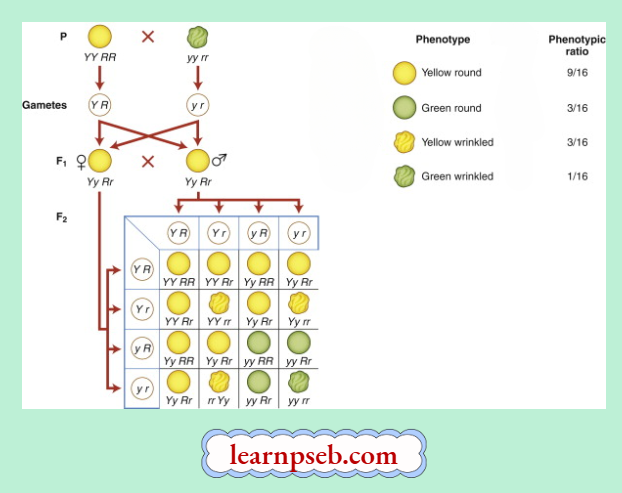
1. Which two pairs of contrasting characters are involved in the above parental cross?
- Round, yellow and green wrinkled
- Round green and yellow wrinkled
- Wrinkled yellow and round green
- Flat yellow and constricted green
Answer: 1. Round, yellow and green wrinkled
2. What is the genotype of the parent with round and wrinkled seeds?
- RRYY
- RRyy
- RrYy
- rrYY
Answer: 2. RRyy
3. In the FI generation, what is the phenotype of the offspring?
- Round and yellow
- Green and round
- Green and wrinkled
- Round and wrinkled
Answer: 1. Round and yellow
4. How many heterozygous offspring are produced in the F2 generation, if a total of 16 offspring are produced?
- 12
- 14
- 16
- 4
Answer: 2. 14
5. What is the ratio of parental combination to recombinants?
- 1:7
- 3:4
- 1:3
- 3:1
Answer: 1. 1:7
Question 6. Peter Norman, a leading UK podiatrist who has been treating the Royal Ballet for 16 years, has seen a lot in his days. He says it’s common for dancers to tape their feet simply and go on pointe with broken toes or stress fractures. He says it’s due to the pressure and insecurity of their jobs. People push their limits to keep their position. The constant pressure on the tip of their toes and the quick bursts of jumping in the air and landing perfectly, the stretching of their tendons and feet fit into impossible shaped shoes has altered the shape of their feet. But for a lot of dancers, this has become a part of them and a part of how they survive these shoes. Most of them won’t allow their doctors to remove the thickened skin at their toe-heads because that is how they survive the shoes. Norman claims he has seen patients whose feet require at least a few weeks to a month’s rest, but they refuse to take more than a night. Among men, it’s different for they wear soft canvas shoes. There’s a lot of jumping and lifting women involved and that results in ankle and tendon injuries.

- Why do you think ballerinas are made to do this to their toes?
- Do you think these injuries will make any changes in their DNA Or genes?
- Will their offspring be born with such feet?
- Is it an acquired or inherited trait?
Answer:
- There’s a lot of jumping and lifting women involved and that results in ankle and tendon injuries. However, due to the pressure and insecurity of their jobs, they refuse to take proper treatment and rest and push their limits to keep their position.
- No.
- No, because this is not an inherited trait.
- Acquired trait.
Question 7. Haemophilia is an X-linked disorder characterized by the inability to properly form blood clots. Until recently, haemophilia was untreatable, and only a few haemophiliacs survived to reproductive age because any small cut or internal haemorrhaging after even a minor bruise were fatal. Now haemophilia is treated with blood transfusions and infusions of a blood derived substance known as antihemophilic factor. However, the treatment is very expensive and occasional problems can arise because of a patient’s allergic reactions or other transfer complications. Haemophilia affects males much more frequently (1 in 10,000) than females (1 in 100,000,000). This occurs because a critical blood clotting gene is carried on the X chromosome. Since males only carry one X chromosome, if that is defective, haemophilia will immediately show up. An early death is likely. Females, on the other hand, carry two X chromosomes. If only one is defective, the other normal X chromosome can compensate. The woman will have normal blood clotting; she will simply be a carrier of the recessive defective gene. This fact will be discovered if some of her children are haemophiliacs. Naturally, women haemophiliacs are rare because it takes two defective X chromosomes in order for the condition to be seen.
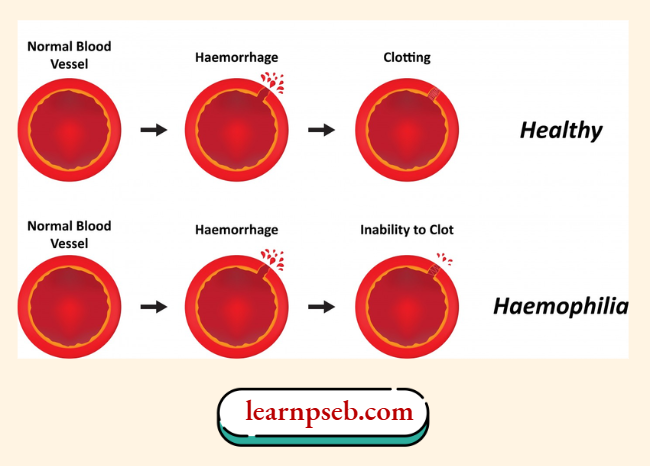
- What are the problems associated with haemophilia?
- How does this disease gets transferred?
- Do you think these will make any changes in the DNA/ genes?
- Can the offspring be born with such a disease? Does the female have more chances to get the disease or the male?
- Is it an acquired or inherited trait?
Answer:
- Inability to properly form blood clots.
- Since the blood clotting gene is carried on the X chromosome, t gets transferred from parents to offsprings through chromosomes.
- Yes. Blood clotting gene is carried on the X chromosome. Since males only carry one X chromosome, if that is defective, haemophilia will immediately show up. An early death is likely. Females, on the other hand, carry two X chromosomes. If only one is defective, the other normal X chromosome can compensate. The woman will have normal blood clotting; she will simply be a carrier of the recessive defective gene. This fact will be discovered if some of her children are haemophiliacs.
- Yes, the offspring can be born with such a disease. Blood clotting gene is carried on the X chromosome. Males have more chances to get the disease since males only carry one X chromosome, if that is defective, haemophilia will immediately show up. An early death is likely. Females, on the other hand, carry two X chromosomes. If only one is defective, the other normal X chromosome can compensate. The woman will have normal blood clotting; she will simply be a carrier of the recessive defective gene. This fact will be discovered if some of her children are haemophiliacs.
- Inherited trait.
